Birds | Butterflies | Insects | Mammals
In this section, you will find some interesting information about mammals, that is the animals that you might find in hedges and similar areas.
These animals are listed in alphabetical order:
Badger

About the Badger:
The Badger is one of the most easily recognised of our mammals, having a white head a dark stripe on either side which includes the eye. Badgers are the largest of our woodland animals. The badger’s burrow is called a “Sett”. The badger has short, strong legs, long feet where the heels touch the ground, straight strong toes adapted to burrowing. They live in dense undergrowth and are mostly nocturnal. It eats fruits, roots, beechnuts, eggs, young birds, small frogs, snails and insects and it also feeds on honey and on larvae of wasps and wild bees. The shaggy hair of the badger is to protect it against stings.
Bat – Daubenton’s Bat
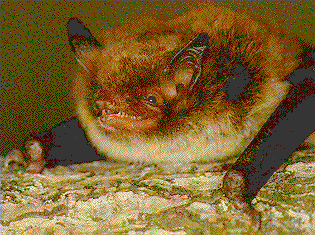
About the Daubenton’s Bat:
This is a small species, with a pinkish-brown face and large feet. The fur on their upperparts is dark grey/brown and the underparts are silvery grey. The wings and tail membrane are dark brown. They like to live in wooded country, often near water. They hunt over the open water and around trees, preying on small flying insects such as mosquitoes, gnats and moths. They hibernate from September to April and there may be several thousand individuals in one colony. During the summer they roost in tree holes and attics, and in the winter they roost in caves, tunnels and cellars. They leave their roosts to hunt at twilight, and they are fast agile fliers.
Bat – Leisler’s Bat

About the Leisler’s Bat:
Leisler’s Bat is the largest bat found in Ireland. Ireland is probably their European stronghold. It is thickly furred, dark brown with a mammal face. The ears are large and broad and have a club-shaped element. They roost in dense groups in attics but hibernate in holes in trees as well as in ruins. They hibernate from mid-November to March. In flight they have a high metabolic rate and must eat a lot. This is a problem because maintaining a high body temperature can be difficult when food is scarce. They therefore save energy when necessary by lowering body temperature and not moving about.
Bat – Lesser-Horseshoe Bat
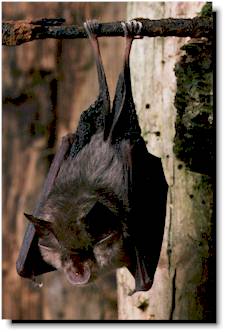
About the Lesser-Horseshoe Bat:
The Lesser-Horseshoe Bat is about as big as a plum and is one of the smaller species. They roost in old buildings in sheltered valleys with deciduous woodland, including hedges. It is found West of the Shannon, in North Co. Clare. They hunt close to riverside vegetation and in dense vegetation. They come out of their roosts about an hour before sunset. They like to eat craneflies i.e.’ daddy-longlegs’, caddis flies, moths and lacewings. They use a low range of ultrasound between 105 and 115 kHz to locate their prey. Their complex nose leaves are used as a reflector to alter the shape of the sound beam.
Bat – Natterer’s Bat
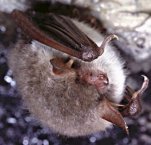
About the Natterer’s Bat:
The Natterer’s Bat can weigh up to 12g in autumn and their weight then declines in Winter to 7g. They are very small with a broad wingspan of 21cm to 24cm. They are very rare and are a forest or woodland animal, roosting in tree-holes. Their summer roosts are in old buildings.They come out to hunt about an hour after sunset and fly around trees or in the woodland canopy. They catch insects such as caddis flies and moths in the air and pick resting insects off the leaves of trees which is known as ‘gleaning’.
Bat – Pipistrelle Long-Eared Bat

About the Pipistrelle Long-Eared Bat:
Their Irish name is Laltog Fheascrach which means ‘bat of the evening’. It is our most common bat since records began to be collected in the 19th century. It is Ireland’s second smallest bat, after the Natterer’s bat. Its teeth are long and very sharp, great for piercing the tough outer skeleton of insects. They come out at dusk from roosts near woods or hedgerows, because in shaded areas the poorer light make them more difficult to be seen. Barn and long-eared owls hunt them. When feeding really well, they may catch 15 insects a minute and may eat up to 3500 insects in one night. Their roost site, usually in an old building, must be close to trees, woods or hedgerows.
Bat – Whiskered Bat
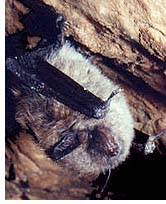
About the Whiskered Bat:
The Irish name Giobach means ‘shaggy’. It is a very rare mammal but has a particular connection to hedges as it hunts along hedges, over open deciduous and coniferous woodland and in scrub areas. They catch small insects such as moths in the air and ‘glean’ small insects and spiders off leaves. In summer they roost in houses, in winter they hibernate in hollow trees or in cavities in old buildings. They may be active all night and return to their roost only at dawn.
Fox
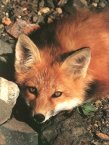
About the Fox:
The Fox or Sionnach / Madra Rua is in many place-names in Ireland e.g. Foxrock in Dublin, Pollnashinnagh in Co Galway or Cloonshannagh, Cloonshinnagh,etc. Also any Irish name with ‘maddy’ such as Glennamaddy in Cork or ‘vaddy’ such as Limmavaddy in Derry. The fox is the only wild member of the dog family and is found in almost every part of Ireland. It is noted for its brown-red coat, long muzzle and bushy white tipped tail. The foxes live in woodland areas and can run for long distances, swim well, climb trees and it has a great sense of smell. They may bark three times or vixens may use a scary scream in the breeding season in winter. They excavate underground dens in banks, enlarged rabbit burrows, disused badger setts or under hedges. It is a carnivore and eats rabibts, young hares, brown rats and wood mice.
Frog – Common Frog

About the Common Frog:
Frogs are small amphibious animals with smooth, moist skin, bulging eyes that can see in almost any direction, external eardrums behind the eyes and no tail. Most species have long hind legs that enable them to take long leaps, and webbed feet, making them excellent swimmers. Most frogs, especially males, are quite vocal. As the frogs forces air from the lungs, vocal cords in the voice box, vibrate to make calls distinctive of its species. Frogs prefer to live in moist areas. Frogs burrow in mud to hibernate. Frogs eat small fish, insects, worms and spiders.
Hedgehog

About the Hedgehog:
Earliest records are from Waterford so it probably came here with the Normans in the 13th century.Their Irish name is Grainneog which means the ‘horrible one’ because they roll into a ball when danger is near and it has dark, brown spines with a pale tip. Each spine is replaced after about one year. Place names include Meenagranoge, the ‘hedgehog’s field’ in Co. Donegal. They root around at night seeking slugs, snails and other invertebrates so they are good for your garden but the presence of slug pellets will kill them. They also eat eggs, other mammals, carrion, berries and fruit if available. They are attracted by shrubberies and flowers which provide cover. Their predators are foxes, badgers and cars!
Lizard – Viviparous Lizard
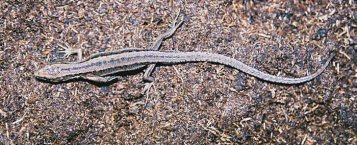
About the Viviparous Lizard:
Ireland’s only lizard, the Viviparous lizard or Earc Luachra, is found in all sorts of dry places but they favour sandy or rocky places, particularly near the sea. Insects and other invertebrates that can be caught are the lizard’s food. Like other animals that are found against backgrounds of variable pattern, its subtle tones and markings render it inconspicuous in its environment. It is generally yellowish brown with irregular blackish markings along the length of its body but it can look greyish or greenish in different situations. The skin is beautifully segmented with scales. The young are produced live hence its name and not from eggs as is normal with reptiles. On being grabbed by the tail the lizard can escape by detaching itself from its tail.
Mink

About the Mink:
Minks live in wooded areas near streams and live in burrows or under roots of trees. They have partly webbed hind feet and are good swimmers. Minks feed on fish, mice, rats and birds. The fur of the wild mink varies from light brown to a deep blackish brown. Their fur is highly prized and today more than half the mink used in the fur industry comes from animals raised on mink farms. They over-populate the areas they live in and can cause damage to farm animals.
Mouse – Wood Mouse

About the Wood Mouse:
The Wood Mouse or Luch Fheir: the Irish word ‘luch’ occurs in the place-name Inchnalughoge – the ‘mouse’s meadow’ in Co. Clare. The earliest record is a tooth found at Clondalkin near Dublin dating from 7600 years ago. Some wood mice are descended from mice which came on Viking longships. It lives high up in the hedge in autumn and winter, searching for fruit until the last rose hips go in February. They eat mainly seeds but also fruits and fungi and invertebrates. They use old nests as feeding platforms, filling them with the litter of hip and acorn left-overs. In summer many are found in cereal fields. It has a brown coat and is whitish underneath, while its dark eyes and pale ears are prominent.
Newt – Common Newt

About the Common Newt:
The Common newt or Earc Sléibhe is the only species of newt found in Ireland. Newts spend the summer in fresh water and hibernate in winter, usually beneath stones. The female newt is light brownish, paler underneath, and the larger male is greyish and profusely spotted with black. In spring when the pair have taken up residence in a pond disused well or other freshwater habitat, the male develops a bright orange belly flush with blue and red markings on the tail. A long wavy crest along the back is used to full effect in an elaborate underwater courtship display. Eggs are laid individually in a folded pondweed leaf; these hatch out into tadpoles complete with gills for underwater breathing.
Otter

About the Otter:
The Otter lives in what is called a “Holt”. They are the common along the river bank. Otters are carnivores. They eat small water birds, frogs and water voles, but most of all they like fish. They breed in the spring. Otters are in danger because they are hunted for their fur. Although Otter hunting is banned in many countries, they are under threat because people have taken over places where they live, or polluted the rivers and lakes. Otters need to be protected. Otters hunt mostly at night and use their hind feet like flippers.
Pine Marten
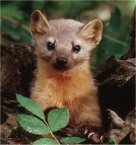
About the Pine Marten:
The Pine Marten or Cat Crainn is Ireland’s rarest wild animal. It is usually found in the West and South of Ireland. They are a shy animal and are also very hard to find. Their coat is usually a rich, dark brown in colour. Pine marten’s are sometimes called Marten Cats in some parts of Ireland. But they have shorter legs and longer bushy tails than cats. They are a woodland animal, with good strong feet and claws for climbing. The Pine Marten defends itself fiercely if attacked by other animals. As it start’s to get dark the Pine Marten slip’s out of its den and starts a night’s hunting. In winter and spring they eat rats, mice, rabbits, small birds, and beetles. They nest and rest usually above ground.
Rabbit

About the Rabbit:
Introduced to Ireland by Normans for meat, it used to be raised in rabbit warrens and this can be seen in some place names today like Warrenhouse Road, Baldoyle. The warren is a maze of tunnels, which can cover a small field. They feed on grass, plants, herbs and the bark of trees and shrubs. They can cause damage to farmland as they eat the roots as well as the leaves of grasses. They are found in the sandy bottoms of hedges or on the dry banks of field boundaries. It is easy to recognise by its white ‘puffball’ tail which jerks as it runs away. Its fur is usually grey-brown with variations from black to white.
Rat – Brown Rat

About the Brown Rat:
The Brown Rat probably came from eastern Asia and reached Ireland about 1722 aboard ships coming from Russia or eastern Europe, by 1730 it was already a pest in Dublin. They live anywhere and breed mainly in summer. They eat anything but are mainly vegetarian. Because they live in sewers and near rubbish tips, they pass on “Weils” disease to humans which can be fatal. It is preyed on by foxes, dogs, cats, stoats and barn owls. They are good swimmers, jumpers and climbers. They mostly come out at night but forage by day when food is near.
Shrew – Pygmy Shrew
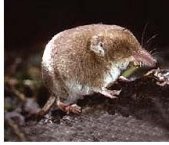
About the Pygmy Shrew:
The Pygmy Shrew is our smallest mammal and has the shortest lifespan. It is found where there is thick cover, in scrub or under hedges. They have a narrow flexible snout which twitches as it sorts through leaf litter seeking food. They have long whiskers, small eyes and short ears which are hidden in the hair. They make their own mammal runs use those of mice and voles. Their eyesight is poor and they rely on their sense of hearing, touch and smell. They can climb well and swim. They came to Ireland after the last ice age. about 10,000 years ago. They eat beetles, woodlice, flies, insect larvae, spiders and bugs. Owls, foxes and cats hunt them!
Squirrel – Grey Squirrel

About the Grey Squirrel:
The Grey Squirrel is brownish grey with a pale underside, although in the summer they have a reddish tinge. On the ground they move irregularly, sitting upright sometimes to look around. They mark their sites with secretions from mouth glands and with their urine. It was introduced to Ireland on an estate called Castle Forbes in Co. Longford 90 years ago. They are attracted by large-seeded trees like oak,sycamore and beech. They live in hedgerows and subrban gardens as well as in forests. They forage on the ground in winter but in summer spend more time in the trees. Their nests are called “Dreys”, located in a forked branch and are enclosed in winter but on twig platforms in the summer.
Squirrel – Red Squirrel

About the Red Squirrel:
They were brought to Ireland in the 19th century to such sites as Ashford, Lucan, Birr and Multyfarnham. It is mainly found West of the Shannon, across most of Munster and South Leinster as well as in the Glens of Antrim. Red squirrels are plentiful in woodland areas. They spend time on the ground foraging for food. They eat nuts from the woodland and they occasionally eat insects. In winter squirrels hibernate and come out to feed from their store of food. They have sharp teeth to crack open nuts. Often the heap of cracked nuts give way their “Drey” high up in a hollow of the tree. Their colour is brown but varies from greyish brown to chestnut red.
Stoat

About the Stoat:
The Irish for Stoat is Easog. Famous for how it can kill much larger animals, it bites the nape of the victim’s neck. Their coat is reddish-brown with a whiteish underbelly and a black tip on the tail. It is a very curious creature and can be mistaken for a weasel which is smaller and does not occur in Ireland. They belong to the same family as the Mink, Pine Marten and Badger. Their dens are found in rabbit burrows, hollow trees or rock crevices. They are solitary and intolerant of others of the same sex. They are carnivores, hunting by ambushing, stalking, chasing or mesmerising.
Toad – Natterjack Toad
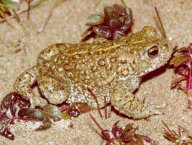
About the Natterjack Toad:
The Natterjack Toad is the only toad found in Ireland and the rarest amphibian. It occurs in just one small area in Kerry where it lives in coastal sand dunes and breeds in lakes, pools and drains containing water which ranges from fresh to brackish. It is now considered to be seriously endangered and facing the prospect of extinction, unless immediate conservation action is taken. The Natterjack Toad is protected under the Wildlife Act but many of the habitats of the remaining viable colonies are not protected by existing legislation.
Wild Cat

About the Wild Cat:
The Wild Cat is now extinct but present in Irish placenames like Lisnagat or ‘the fort of the wild cats’. The early Irish word ‘catt’ is Celtic and probably applied first to the wild cat. Feral cats are domestic cats living wild, mainly due to being abandoned by people. They can be tamed if they are caught as kittens usually up to the first six weeks thereafter it becomes harder. It all depends if the kittens were born to an abandoned female who has gone wild, or are from several generations of feral cats – the latter can only be tamed if caught when very young.
Wild Pig

About the Wild Pig:
Now extinct in Ireland but there used be a lot of them from their frequent mentioning in place-names: Muckinish ‘pig island’, Muckno ‘swimming place of the pigs’ , Muckross ‘pig peninsula’ and Ballynamuch ‘town of the pigs’. Hair color is variable from brown to black. The body shape of the Wild Pig is similar to that of domestic pigs, with a few differences which make them distinct. The Wild Pig is generally thinner, has coarser hair, and has longer canine teeth, called tusks, than domestic pigs do. A Wild Pig will eat almost anything that has nutritional value, including tubers, roots, shoots, acorns, fruits, berries, earthworms, amphibians, reptiles, rodents.
Vole – Bank Vole

About the Bank Vole:
Bank Vole’s are newcomers to Ireland where it was first seen in 1964 in Kerry and it probably came as a stowaway on ships sailing up the River Shannon. They like to live in bramble, scrub and hedges. They eat berries, seeds, fungi and bark but also enjoy the odd insect. It has reddish-brown fur and it has a greyish long underbelly. It has short legs and long toes which is very useful for gripping when it climbs. They make high-pitched sounds which we cannot hear as well as squeaks. They use hedges as corridors and are very active at dawn and dusk.
Wolf

About Wolves:
Extinct since the 18th century. Place-names like Breaghva or ‘plain of the wolves’. An Irish tribe actually claimed ancestry from the wolf and Cormac, a King of Ireland, was reputed to have been suckled by a she-wolf. Wolves as carrion eaters were also linked in many cultures with death – the night and the moon adding to the image. Among the ancient Irish, two dogs were said to guard the gates of death that led to Emaina – ‘Moonland’. Wolves were a common feature of the Irish landscape until 1786 when the last one was killed.
